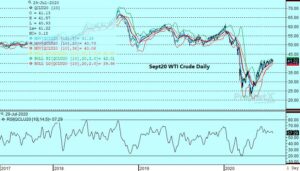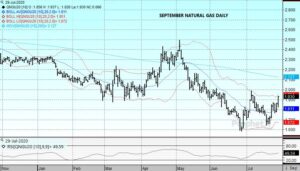Price Overview
The petroleum complex continues to trade in a lackluster fashion as participants await fresh economic direction and guidance on prevailing supply/demand trends. The pandemic continues to move unevenly through the global economy with the US most affected by divergent trends in mobility. Key to the outlook will be the level of stimulus to the domestic economy by Congress and its impact on work and entertainment patterns. In addition US-Sino relations remain a center of focus given the substantial impact it might have on the Chinese economy and petroleum consumption and the associated increase in petroleum imports from the US market. Underlying support continues to be evident as weakness to the dollar along with the strength to hard assets has helped limit selling interest on ideas that stimulative monetary policies will lead to a steady build in inflationary pressures.
The adequacy of supplies and large inventory overhang along with continued uncertainty over the demand side as we enter the fall continue to limit upside progress. Nevertheless the DOE report did help underpin values and provide some encouragement that inventories are being drawn down. The report showed crude inventories falling by 10.6 mb, putting commercial inventories at 526 mb but still above year ago levels of 436.5 mb. Capacity utilization rose modestly to 79.5 percent from 77.9. Gasoline inventories showed an increase of .7 mb while distillate rose by .5 mb. Implied disappearance for all products showed a sharp increase reaching 19.1 mb against 17.6 mb last week and 21.3 mb last year. Large increases were noted for distillate, gasoline and propane.
Supply issues remain in the background as prospects for future production expansion and capital investment are assessed in light of OPEC+ restraint and the waning profitability of US shale oil producers. A big question is whether a relaxation of OPEC quotas in August leads to a higher level of compliance or not. They are hoping that producers such as Iraq, who had overproduced in the past few months, will compensate with lower production levels from July onward. Excess inventories that had built up as demand fell still need to be absorbed. The speed at which these stocks are drawn down will be a key determinant as to whether price strength can be sustained.
The market still looks vulnerable to downside price pressures if the recent high of 42.50 basis September is not violated. The appearance that US production has stabilized and the recovery in global output might be temporary could lead to fresh pressure on values. A penetration of the 40.35 level basis September could be the first sign of a more significant breakdown to values back to at least the 38.50 level and possibly 35.00.


Natural Gas
Prices returned to there somewhat surprising upward bias after taking a breather on Monday. Steady buying interest flowed into the market as prices worked higher to end the session up by over 6 cents at 1.93 basis the active September contract, which followed a nearly 8 cent jump yesterday. No specific driver could be pointed to for the surge, while a number of factors lent varying support. The emergence of another potential storm in the Caribbean that could lead to production disruptions in the Gulf rekindled the active storm season fears, with some short term pipeline supply issues adding momentum. Exports to Mexico have been improving and are on pace to surpass previous highs, while nuclear outages have maintained there above normal trend for the last 10 days which has translated into over 1 bcf/d in replacement gas demand that aided in strong power burns. Production remains steady and a current burden to prices, but trade continues to look for further declines to develop into the fall in tandem with expected improvement to the LNG situation. The warm weather pattern has taken a breather, but longer term forecasts into mid/late August are pointing to a return to above normal temperatures. The strong close suggest follow through to test the early July highs near 2.00, with the 2.04 area marking a 50 percent retracement of the May-June break. Any pullback in prices should find support near 1.80. We are removing our recommendation to buy the December natural gas as our entry level was not reached.
Charts Courtesy of DTN Prophet X, EIA, Reuters.
Futures and options trading involve significant risk of loss and may not be suitable for everyone. Therefore, carefully consider whether such trading is suitable for you in light of your financial condition. The information and comments contained herein is provided by ADMIS and in no way should be construed to be information provided by ADM. The author of this report did not have a financial interest in any of the contracts discussed in this report at the time the report was prepared. The information provided is designed to assist in your analysis and evaluation of the futures and options markets. However, any decisions you may make to buy, sell or hold a futures or options position on such research are entirely your own and not in any way deemed to be endorsed by or attributed to ADMIS. Copyright ADM Investor Services, Inc.
